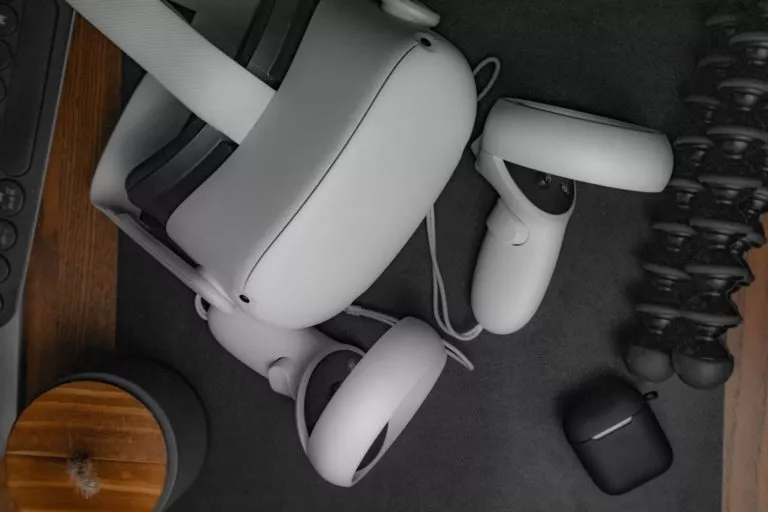
As you may have heard, Meta announced Q3 earnings last week. Meta Reality Labs’ (MRL) revenue hit record lows while Meta outperformed in a broader sense. Among other things, top-line and bottom-line revenue were up, signaling a meaningful rebound for Meta’s core business.
Back to MRL’s dark spot, Q3 revenue was $210 million which is down 24 percent from Q2 (quarter-over-quarter) and 27 percent from Q3 2022 (year-over-year). The revenue decline was due to a combination of a maturing Quest 2 and dampened discretionary consumer spending.
Regarding the aging Quest 2 and its impact on revenue declines, this makes it a perfect time for Quest 3 to come along to re-envigorate VR demand and stimulate a replacement cycle. That plus the traditionally VR-strong holiday period has us looking to Q4 for an MRL top-line rebound.
There’s a lot to be said about that timing and market positioning (more on that in a bit). But our main question is how Q3 revenue translates to VR unit sales. This is an exercise we’ve done every quarter for several years, which helps inform broader VR momentum and market sizing.
Data Dive
Diving in, Reality Labs made $210 million in Q3, as noted. Based on Meta’s past disclosures, we’ve extrapolated that VR software (game and app sales) is about 23 percent of that. That makes software revenue approximately $48.3 million*, leaving $161.7 million for hardware.
VR Headsets are an estimated 92 percent of that, the rest being first-party accessories like head straps, as well as Ray-Ban Stories. That brings us to $148.76 million for headset sales. That’s both Quest 2 and Quest Pro, the former accounting for an estimated 94 percent of revenue.
For Quest 2…
Based on the above, Quest 2’s estimated revenue is $139.84 million. Considering an average unit price of $315** this means that Meta sold approximately 443,931 Quest 2s in Q3.
For Quest Pro…
Based on the above, Quest Pro’s estimated revenue is $8.93 million. Considering a Q3 unit price of $999 (the price dropped from $1,499 in Q1) this means that Meta sold approximately 8,934 Quest Pros in Q3.
Adding up both headsets, we get an estimated total of 452,865 units sold in Q3.
*This figure represents the Oculus Store’s gross revenue, before developer payouts, which are usually 70 percent after taxes. Meta realizes 100 percent of revenue in some cases, such as first-party titles and releases from VR game studios it has acquired (e.g., Beat Games).
**During Q3, a recent price drop positioned Quest 2’s base model (128GB) at $299 while the 256GB model was $349. This averages out at $315 given weighted sales at the lower end.
The Bigger Picture
Back to the bigger picture, MRL is down but Meta overall is up. Though this seems like bad news for MRL, broader financial gains in Q3 serve the division well. In other words, Meta won’t be slammed so much on PR levels for investing in passion projects while the ship was sinking.
Now that it has righted the ship, big investments in emerging tech aren’t such a bad look. Combine that with the fact that Meta has turned the volume down on its metaverse ambitions. Work still continues at MRL, but Meta has learned not to trumpet those efforts so loudly.
All of the above speaks on PR levels. But on practical levels, a declining core business was exactly the time to be building lifeboats. And that’s what MRL is – a necessary investment to future-proof the company. This will continue, though quieter and pared back to some degree.
Moreover, Meta’s investments in VR hardware and an operating system make it a bonafide platform. That engenders vertical integration and less dependence on having to piggyback on others’ platforms (read: iOS and Android). Meta has learned this lesson the hard way.
Bottom line: amidst all the schadenfreude, Meta continues to build for the long haul… though it’s following Wall Street signals (rightly so) to lower the volume on the Metaverse. The important part is that it’s using today’s dollars to build tomorrow’s business, now more judiciously.
As for the near future in Quest land, all eyes are on Q4 given the standard holiday boost and the first quarter of Quest 3 sales. Adding to the mix (and our financial model above) will be sales of Ray-Ban Meta Smartglasses, which could be more consequential than their predecessor.






